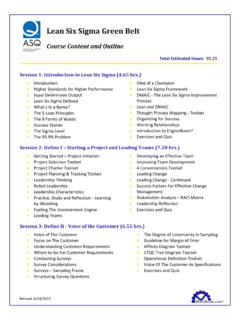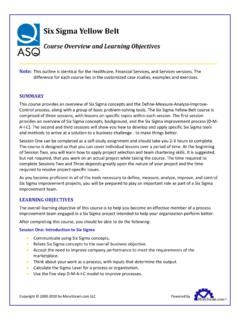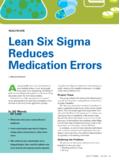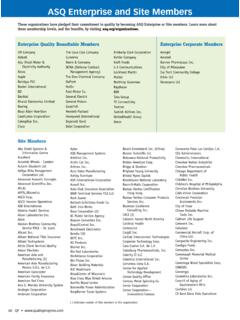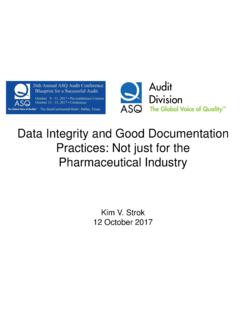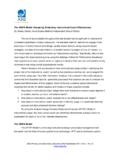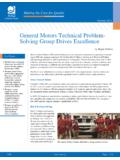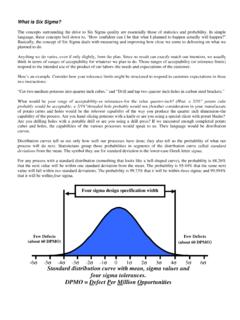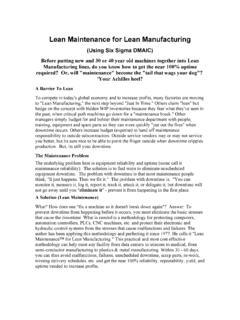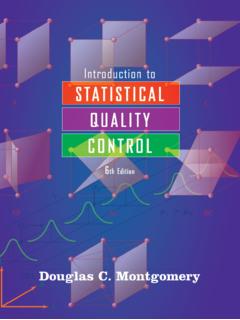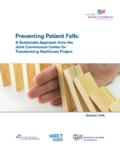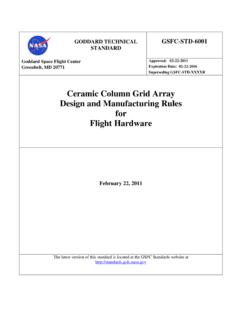Transcription of Paper: Six Sigma and Its Application to Healthcare - The ...
1 SIX Sigma AND ITS Application TO Healthcare . A CASE STUDY. The Application of Six Sigma Strategies to Medication Administration. Ed Chaplin San Diego NB: Before beginning - many of the examples here could have been improved with a modern information technology systems. At the time of the project that option was not available. Indeed, the IT human habit interface is proving to be a major barrier to deploying strategies such as computerized physician order entry systems. Many hospital systems have repeatedly delayed their deployment and some have temporarily stopped their deployment. The purpose of the example is to show the tools of Six Sigma can be used.
2 INTRODUCTORY COMMENTS. It is hardly news to anyone that the Healthcare system in the is a mess. Consumers complain about the lack of choice, payers about high cost and a stream of horror stories about medical errors in the national and local media have made everyone anxious about safety. Hospitals as Systems: Systems always produce results that are consistent with their underlying structure not with the expectations we have for a system. On close inspection hospitals as systems are woefully inefficient and inadequate relative to what we expect from them and they are unlikely to met community expectations until at lease four fundamental changes occur.
3 First, hospitals must become more visible and understandable to the community to create public accountability. Hospitals and medical groups performance has been cloaked in secrecy rendering performance invisible to outsiders. Current consumers have much more access to cost, performance and reliability data on automobiles, computers and home appliance than they do the Healthcare services. Second, hospitals and physicians must use the latest scientific evidence as the basis of their practices. This may sound strange as we think of medicine as a science, but studies not that long ago show that 80% of what is done in medicine is done out of tradition not science.
4 (1,2,3). Third, hospitals and physician groups must use up-to-date quality improvement and error reduction methods. Hospitals and physicians often see themselves on the cutting edge of science in the Application of technology but, in fact, they have been consistently a full ten years behind manufacturing in adopting the tools for quality and error reduction. (4). Finally, consumers of Healthcare services must share in more of the initial financial risk in order to have a greater economic voice in the marketplace. Consumers need to be able to reward and penalize sellers of insurance and Healthcare services based on what they offer and what they deliver in a way that matters to sellers, in dollars.
5 The Path: The path out of the current crises that affect hospitals is pretty clear. The technical know-how to deal effectively with the crises affecting hospitals today already exist in other social spaces The major barrier to incorporating that know-how is our own biology . our individual and collective inertias and mental maps which are inconsistent with how our brains work Catalysts (quality tools and information technology processes) to overcome this inertia have already evolved in other industries The path will require the Application of science and the use of the tools and information technology to design hospital processes that are customer- focused for the delivery of services and management practices that are systems-based.
6 Some people in Healthcare might say you do not understand, Hospitals and Healthcare are much more complex than making widgets. The strategies used in manufacturing do not apply to hospitals. Yes and no. Yes in that hospital services are very complex and involve life and death matters. No in that even the most complex properties of human social organizations are generated and ordered by the communication and the coordination of actions on a person-to-person level. In medicine we typically characterize the body as a system by its structural components (anatomy), the relation of the parts (physiology), the generation and exchange of energy and value (biochemistry) and it relation to the environment (ecology).
7 It is true that we may not be able to anticipate the future structure of the hospital nor its ecological relationship to its community, however, the relations of its parts and the generation and exchange of value will be the same as those in manufacturing just as they are similar between man and other mammals. We share 99% of our DNA in common with the mouse yet our anatomical structure and our social capacities are quite different. It is exactly because Healthcare is complex that tools and processes are required. This particular project applied the strategies, tools and statistical methods of Six Sigma to improve the medication administration process.
8 INTRODUCTION AND DEFINE. Problem Identification: Ongoing quality monitoring indicated several functions in the medication administration process were not conforming to specifications. First, verbal medication orders were not being signed by the prescribing physician within 48 hours as required by regulation. Second, the number of adverse drug events identified was several-fold lower than what is in the literature suggesting that the system to identify adverse drug events and the errors that lead to them was ineffective. Third, there was incomplete documentation of pre-and post-pain levels by the nursing staff when administering pain-relieving medications.
9 Fourth, key vital signs were not routinely documented before administering a powerful cardiovascular medication is a standard practice in hospitals. Fifth, a two-week event that encouraged all employees to identify breakdowns or concerns encountered in services that, if addressed, would improve hospital and staff performance identified problems in the medication delivery system as one of the top three problem-plagued processes. Finally, as everyone is now aware, the Institute of Medicine report suggested hospital errors may kill 98,000 people per year and 25% of those that are preventable are related to medication administration.
10 Scope: The project included the medication administration system from the time an order was written by the physician through the patient's response to the administration of the medication. Sub-processes included ordering, filling, delivery, dispensing, evaluation of the patient's response and evaluation of organizational effectiveness in monitoring the process. Goals and Measures: The project would evaluate the six measures suggested by the Institute of Medicine, timeliness, effectiveness, efficacy, safety, patient satisfaction and equitable distribution of resources with the goal of reducing cost and improving reliability.
